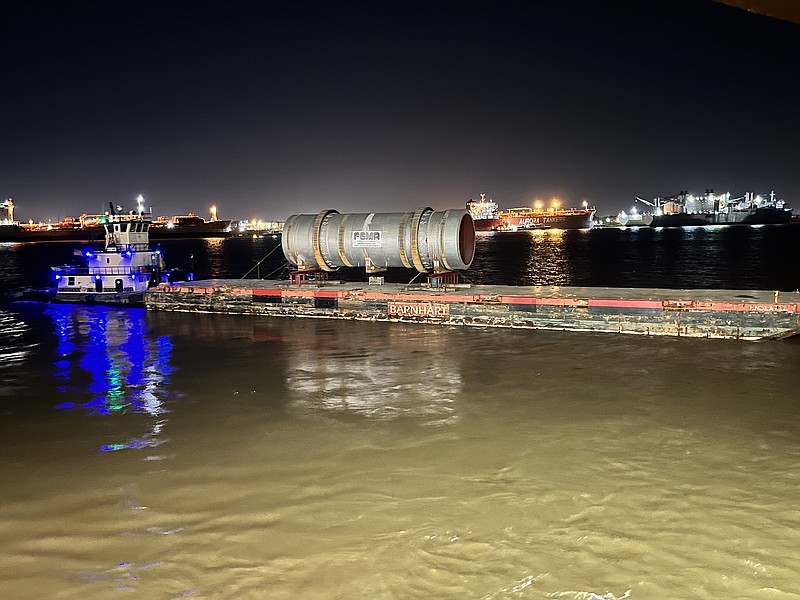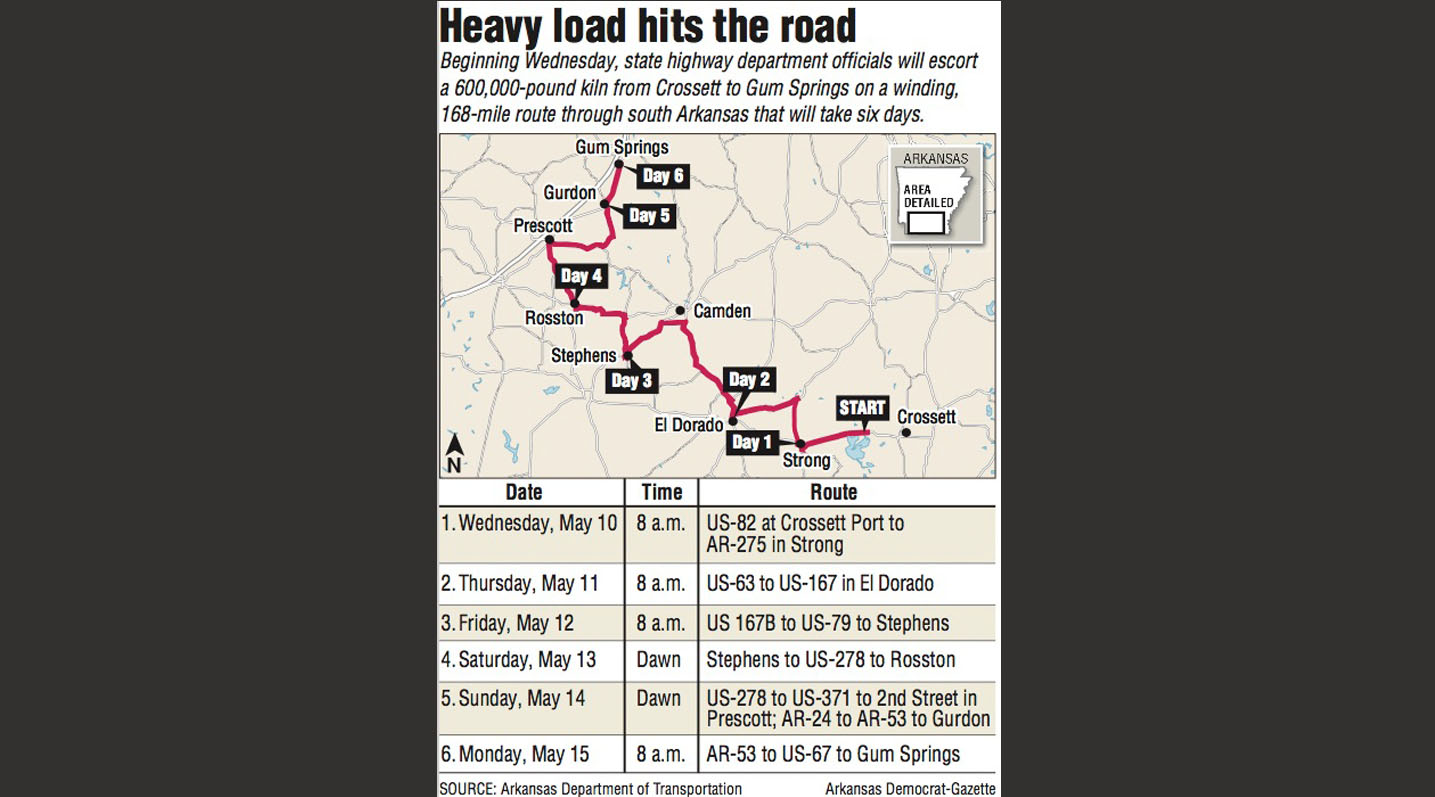How long does it take to drive from Crossett to Gum Springs?
In a normal car and at a normal rate of speed: 124 miles and at least two hours and 17 minutes, according to the default Google Maps route.
If you're part of a convoy transporting a 300-ton kiln furnace?
Strap in, baby, because you're in for a brisk 168 miles in ... six days.
Starting Wednesday and running through May 15, a convoy made up of at least four civilian pickups, a set of push and pull trucks, four bucket trucks and a 12-dolly suspension beam dual lane transport trailer will make that trip.
Assisted by the Arkansas Department of Transportation and Arkansas Highway Police, the convoy is tasked with transporting the kiln furnace to the under-construction Veolia Thermal Hazardous Waste Treatment Operation in Gum Springs.
You're probably wondering what a kiln furnace is.
According to Veolia, the company that operates the waste treatment plant, it is used to safely dispose of complex waste streams through thermal treatment. It will operate at extremely high temperatures with the capability to rotate at different angles to ensure that all waste materials are properly treated.
Plus, it's really big, coming in at 16 feet in diameter and 59 feet long. That's why it will take so long to transport, as the convoy travels between 5 and 20 mph along its route.
This kiln isn't a locally made product, either.
Gum Springs will be its final destination after a journey that began with its construction by a manufacturer in Italy.
After making its way across the Mediterranean Sea and the Atlantic Ocean, it arrived in New Orleans on April 15.
There, it was placed on a barge and it made its way up the Mississippi River to the Ouachita River, to be brought across the state to Crossett.
"Why [it was taken] there is it's so tall, if it gets to the Pine Bluff or Little Rock ports, we can't get it on a highway to get it to Gum Springs," said Capt. Ross Batson, commander of the Arkansas Highway Police's permit section. "It's too tall to get under some overpasses and some railroad passes and certain areas, and its weight is too strong or too heavy."
Batson said that, luckily, "the rainfall [this year] cooperated, because last year if they tried to bring it up in June or May, we were drier, and the Ouachita River was drier, and they might not have gotten the barges to float in some of these sections, but the rain really paid off for us this year to get the river high enough to get it here."
With the push and pull trucks positioned on either end of the dual lane transport, the setup will be 226 feet long, Batson said.
The kiln will rest on the 12 dolly suspension beam dual lane transport, which is provided by Barnhart Crane and Rigging in Memphis.
"We specialize in these over-dimensional [transports], they call them 'mega moves,'" said Tim Fielder, who is part of project sales with Barnhart. "We do this all over the country. The significance of this one is it just moves so far. Typically, these things don't have to move so far over land. This one really isn't so heavy. It's just big and we have to haul it 168 miles."
The dual lane transport is made up of 24 individual axles.
"Basically you have put enough axles under it to meet the Arkansas DOT bridge requirements for axle weights," Fielder said. "The DOT has been working on this project for well over a year to find a safe route and determine the route where the bridges would support it and it would have the least impact with the public."
Once it hits the road, this is the scheduled route the kiln convoy will take, according to the Transportation Department. It will start at 8 a.m. on weekdays and at dawn on the weekend.
Wednesday: U.S. 82 at Crossett Port to Arkansas 275 in Strong.
Thursday: U.S. 63 to U.S. 167 in El Dorado.
Friday: U.S. 167B to U.S. 79 to Stephens.
Saturday: Stephens to U.S. 278 to Rosston.
May 14: U.S. 278 to U.S. 371 to Second Street in Prescott; Arkansas 24 to Arkansas 53 to Gurdon.
May 15: Arkansas 53 to U.S. 67 to Gum Springs
The convoy will go around cities like El Dorado and part of Camden, but it will have to go through the middle of Prescott.
"Because of the roadway and the bridges, we can't get any other better route," Batson said.
Batson said the route was primarily determined by the Transportation Department's automatic permitted routing computer system.
Use of the computerized routing system began in 2008.
"We can put in the truck's width, height, weight, its axles, and the system will look for a route," Batson said. "Say you want to go from Little Rock to Fort Smith, and it will tell us the route. If there's a bridge that does not handle that load, it will look for a better route."
The department then has bridge engineers look at the system to determine if bridges are suitable.
The final route from Crossett to Gum Springs was the fourth one produced by the computer system.
"Once they approved the route, they shipped [the kiln] from Italy," Batson said.
Batson said the kiln convoy will be wider and taller than what the department usually helps transport on highways.
On some small highways, it will take up both lanes.
Contractors, flagmen and message boards will be used when roads have to be closed temporarily.
According to Batson, the Highway Police doesn't "normally escort loads like this, but the chief and director felt like for the safety of the motoring public we ought to be there in case something comes up."
There will be some impediments along the way.
The load is 20 feet tall, which is a challenge when Arkansas' right of way on highways is 18 feet.
"There's going to be a lot of power lines in the way, and so they have four bucket trucks traveling with them," Batson said. "They will be dropping power lines and driving over them or raising them up and going under them as we go."
There's also at least one railroad gate -- which sits at 19 feet high -- along the route that will have to taken down and put back up, which will be done under the supervision of the Transportation Department and Union Pacific.
When it comes to where the kiln and its trailer will stop each night, Batson said there are designated parking spots for it each night and steel pads that it will sit on.
"They've made contact with some property owners with some parking lots and some fields, and I think they're going to use one of ARDOT's wide areas," Batson said. "They put these pads down where it doesn't do any sinking to the ground."
Batson, who has been with the Highway Police since 1986, will be along for the ride for part of the journey.
He'll be on the convoy at least for Wednesday.
Is he ready to move at the blistering pace of 5 mph?
"It's kind of like being on a parade, isn't it?" Batson said with a laugh. "I'm hoping it goes faster."

